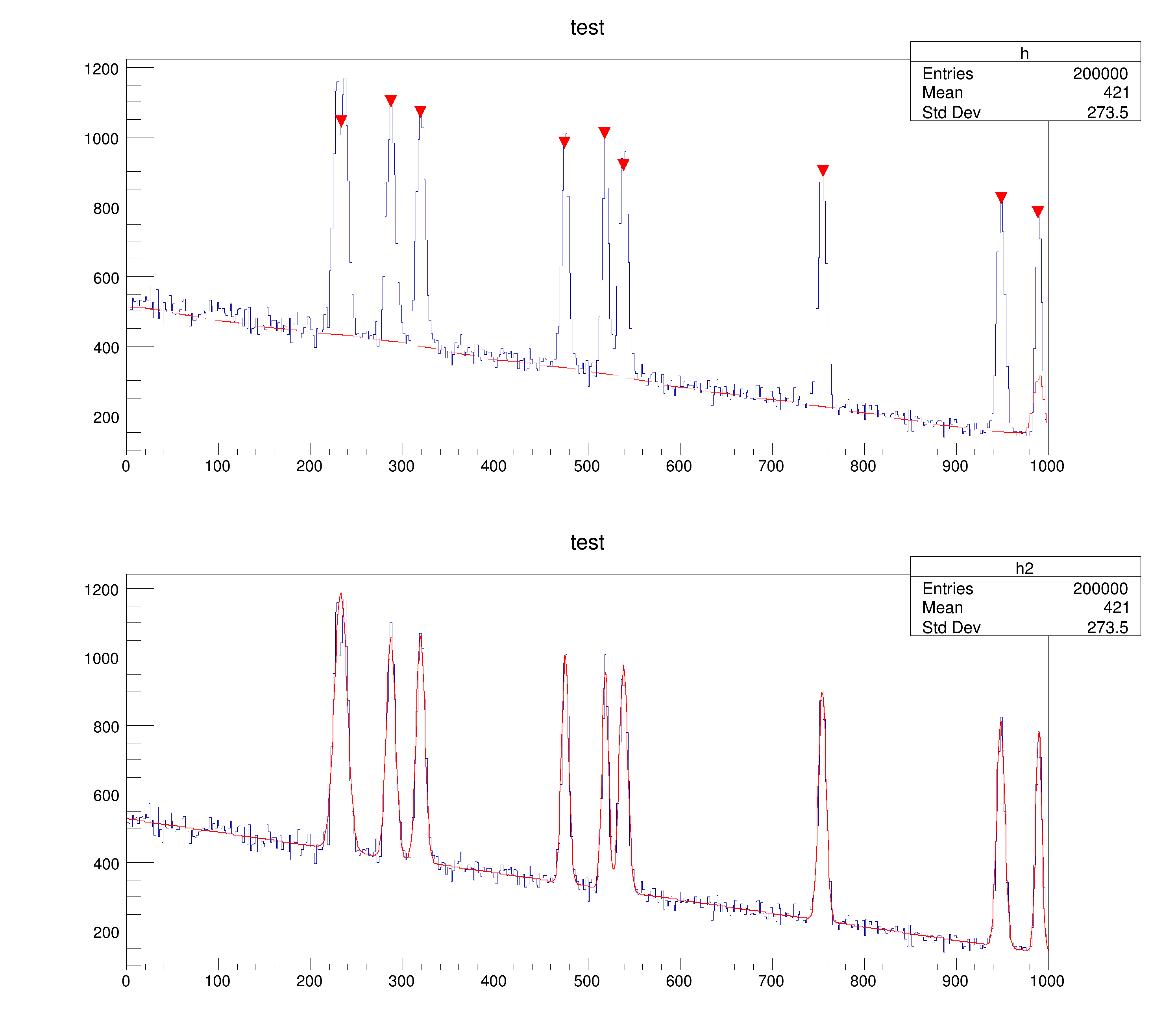
 Illustrates how to find peaks in histograms.
Illustrates how to find peaks in histograms.
This script generates a random number of gaussian peaks on top of a linear background. The position of the peaks is found via TSpectrum and injected as initial values of parameters to make a global fit. The background is computed and drawn on top of the original histogram.
This script can fit "peaks' heights" or "peaks' areas" (comment out or uncomment the line which defines __PEAKS_C_FIT_AREAS__).
To execute this example, do (in ROOT 5 or ROOT 6):
root > .x peaks.C (generate 10 peaks by default)
root > .x peaks.C++ (use the compiler)
root > .x peaks.C++(30) (generates 30 peaks)
To execute only the first part of the script (without fitting) specify a negative value for the number of peaks, eg
0.0222001075745
4.83196902275
Processing /mnt/build/workspace/root-makedoc-v614/rootspi/rdoc/src/v6-14-00-patches/tutorials/spectrum/peaks.C...
Found 9 candidate peaks to fit
Found 9 useful peaks to fit
Now fitting: Be patient
FCN=596.686 FROM MIGRAD STATUS=CONVERGED 1343 CALLS 1344 TOTAL
EDM=3.92392e-07 STRATEGY= 1 ERROR MATRIX UNCERTAINTY 4.1 per cent
EXT PARAMETER STEP FIRST
NO. NAME VALUE ERROR SIZE DERIVATIVE
1 p0 5.27684e+02 2.01895e+00 1.61337e-04 1.75612e-05
2 p1 -3.95030e-01 3.04733e-03 -2.24976e-07 9.00276e-03
3 p2 6.34691e+02 2.03922e+01 6.11343e-03 8.34700e-06
4 p3 5.19331e+02 9.71873e-02 -3.36434e-05 5.32034e-03
5 p4 3.49850e+00 1.08256e-01 -2.36209e-05 1.49297e-03
6 p5 6.64734e+02 1.64194e+01 -1.21344e-03 3.63149e-06
7 p6 3.19147e+02 1.05478e-01 7.08425e-06 2.00939e-04
8 p7 4.69148e+00 9.07160e-02 1.69389e-06 -1.62399e-03
9 p8 6.70930e+02 1.64206e+01 3.50063e-03 -9.49091e-06
10 p9 7.54806e+02 9.99565e-02 1.99123e-05 -2.47890e-03
11 p10 4.29726e+00 7.99677e-02 -3.50356e-05 -3.01093e-03
12 p11 6.69618e+02 1.73089e+01 -7.16995e-03 1.61496e-05
13 p12 4.75964e+02 9.46541e-02 -1.85498e-05 -6.93464e-04
14 p13 3.89327e+00 8.40808e-02 2.51847e-05 -4.75462e-03
15 p14 6.48094e+02 1.48388e+01 1.51648e-02 1.40873e-05
16 p15 9.89666e+02 7.93960e-02 2.05378e-08 5.80091e-03
17 p16 3.34529e+00 5.62112e-02 6.45923e-06 6.69573e-03
18 p17 6.62565e+02 1.83711e+01 9.37343e-03 1.71791e-05
19 p18 5.39268e+02 1.17175e-01 -4.07242e-05 2.90506e-04
20 p19 4.56057e+00 9.79810e-02 -3.17654e-05 1.67849e-03
21 p20 6.59405e+02 1.56865e+01 -5.02844e-03 1.33136e-05
22 p21 9.48476e+02 1.01997e-01 -2.38534e-05 -2.87561e-03
23 p22 4.41169e+00 8.80653e-02 3.30904e-05 -1.55484e-04
24 p23 7.53519e+02 1.46208e+01 -1.21918e-03 -1.58005e-05
25 p24 2.32585e+02 1.49583e-01 4.30086e-05 2.06782e-03
26 p25 6.95026e+00 1.18485e-01 1.79213e-05 3.79338e-04
27 p26 6.45490e+02 1.58541e+01 5.23845e-03 8.39699e-06
28 p27 2.86948e+02 1.20789e-01 7.08536e-05 -1.98488e-04
29 p28 4.98698e+00 9.92605e-02 -3.61574e-05 3.47101e-03

for (
Int_t p=0;p<npeaks;p++) {
#if defined(__PEAKS_C_FIT_AREAS__)
#endif
}
return result;
}
void peaks(
Int_t np=10) {
TH1F *h =
new TH1F(
"h",
"test",500,0,1000);
par[0] = 0.8;
par[1] = -0.6/1000;
for (p=0;p<npeaks;p++) {
par[3*p+2] = 1;
par[3*p+3] = 10+gRandom->Rndm()*980;
par[3*p+4] = 3+2*gRandom->Rndm();
#if defined(__PEAKS_C_FIT_AREAS__)
#endif
}
TF1 *f =
new TF1(
"f",fpeaks,0,1000,2+3*npeaks);
f->SetNpx(1000);
f->SetParameters(par);
printf("Found %d candidate peaks to fit\n",nfound);
if (np <0) return;
TF1 *fline =
new TF1(
"fline",
"pol1",0,1000);
npeaks = 0;
for (p=0;p<nfound;p++) {
par[3*npeaks+2] = yp;
par[3*npeaks+3] = xp;
par[3*npeaks+4] = 3;
#if defined(__PEAKS_C_FIT_AREAS__)
#endif
npeaks++;
}
printf("Found %d useful peaks to fit\n",npeaks);
printf("Now fitting: Be patient\n");
TF1 *fit =
new TF1(
"fit",fpeaks,0,1000,2+3*npeaks);
}
- Author
- Rene Brun
Definition in file peaks.C.



 Illustrates how to find peaks in histograms.
Illustrates how to find peaks in histograms. 